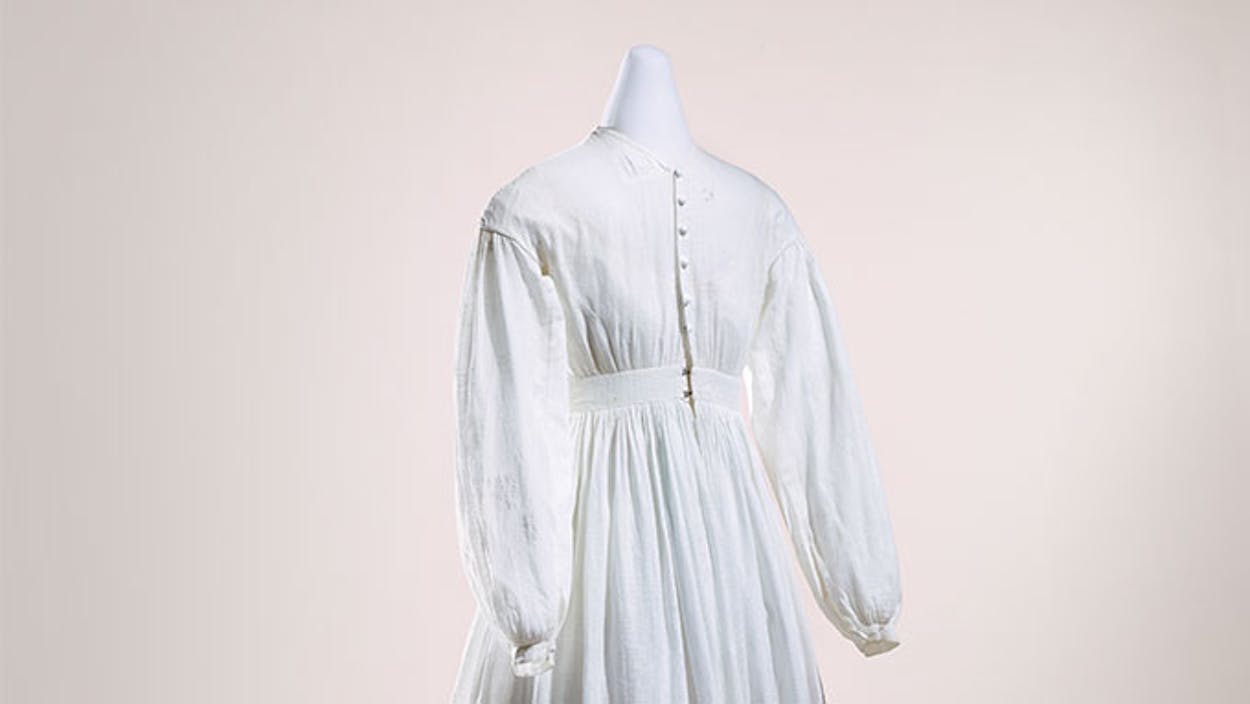Sallie Tate was born into slavery in Maury County, Tennessee, in 1824. Nothing is known about her early life, except that she married when she was 21 and had a daughter who died in early childhood. She could read and write, which means she was probably a house slave rather than a field hand. In the fall of 1853, her owners, James and Selah Edgar, moved to Texas, bringing some of their adult children and their families. They traveled on foot, on horseback, and in wagons; the trip took 52 days. The Edgars came to Texas to claim 1,476 acres of land granted to their oldest son, Joseph, who had left home at the age of 17 to fight in the Texas Revolution and had died in 1837, possibly of a wound received at San Jacinto. The land was located on the headwaters of Cuero Creek, in DeWitt County, and that is where the Edgars settled. They raised cotton, but James was an atypical Texas cotton farmer; he also owned four hundred head of cattle and one thousand hogs, and Sallie Tate was his only slave. His daily farm labor was provided by his two sons and a hired man who lived with the family.
In 1860 Sallie Tate was one of 182,566 enslaved men, women, and children in Texas, according to the census. Slaves, most of whom lived on cotton farms, accounted for one third of the state’s population. They had no personal belongings. They did not own their living quarters or their furniture or the tools they worked with or even their own bodies. These all belonged to their masters. They had no personal clothing. They wore what their masters issued to them, usually in an annual distribution. In some cases, slaves were given so many yards of cloth and expected to sew their own clothes. The cloth was the cheapest and coarsest available, a special weave known as “Negro cloth,” “slave cloth,” or “plantation cloth.” Though no similar documents remain in Texas, historians have a record of the amount of cloth issued annually by a Mississippi planter named Stephen Duncan Jr. to his slaves. Each man and boy received eight yards, in varying weights, from which they were expected to make three shirts, two pairs of summer pants, and one pair of winter pants. They were also given a blanket coat and two pairs of shoes. Women and girls received thirteen yards, from which they were expected to make three shifts, a summer and a winter dress, and a petticoat. They also received a blanket coat and two pairs of shoes. Younger children of both genders were allotted six yards of cloth, which was expected to be enough for four “slips,” or long shirts. Many female slaves fashioned work clothes for themselves by cutting men’s trousers off and tying the legs above their knees.
Texas slaves were freed on June 19, 1865, when federal troops occupied Galveston and General Gordon Granger stood on the balcony of Ashton Villa to announce that, in accordance with the Emancipation Proclamation, issued by Abraham Lincoln two and a half years earlier, all slaves in Texas were officially free. When the news reached Sallie Tate, she chose to stay with the Edgar family. The 1870 census of DeWitt County lists her as a “domestic servant” in the household of her widowed former mistress, Selah Edgar. Also in the home were the two adult Edgar sons and three small children, probably Selah’s grandchildren. However, there was one important difference in Sallie Tate’s life. She was now working for wages. With the first wages she earned after emancipation, she bought ten yards of manufactured white cotton cross-barred fabric, a step above the “Negro cloth” she had worn as a slave, and made herself a beautiful long-sleeved dress, with a full skirt, a set-in waistband, a row of decorative tucks around the skirt, and a very deep hem.
We know a little about the rest of Sallie Tate’s life from the census records. Thirty years after her emancipation, in 1900, at the age of 76 (she told the census taker she was 67), she was living in the household of H. B. and Alice Woodley, in San Antonio, where she was a nurse to the Woodleys’ three-year-old daughter, Alice. In 1910 the census taker found Sallie Tate with the Woodleys on their ranch near Uvalde. Ten years later, the widowed Alice Woodley had moved back to San Antonio and was living with her daughter, now Alice Carney, and her one-month-old grandson, Jack. Sallie Tate was no longer in the household.
In 1926 Alice Woodley presented San Antonio’s Witte Museum with Sallie Tate’s belongings, which today are among the few artifacts of Texas slavery in the state’s museums. Woodley told the Witte that the meager possessions had all been treasured by Sallie Tate, who lived to be nearly one hundred years old. In addition to Sallie Tate’s cross-barred-cotton dress, the items include a string of glass beads, a pair of scissors, a child’s dress worn by her deceased daughter, and a Bible published by the American Bible Society in 1867 and inscribed on the flyleaf: “Sarah Tate’s book. I am a true Christian. Born Feb. 26, 1824.”
Witte Museum, 3801 Broadway, San Antonio (210-357-1900). Open Mon–Sat 10–5, Tues 10–8, Sun noon–5.







